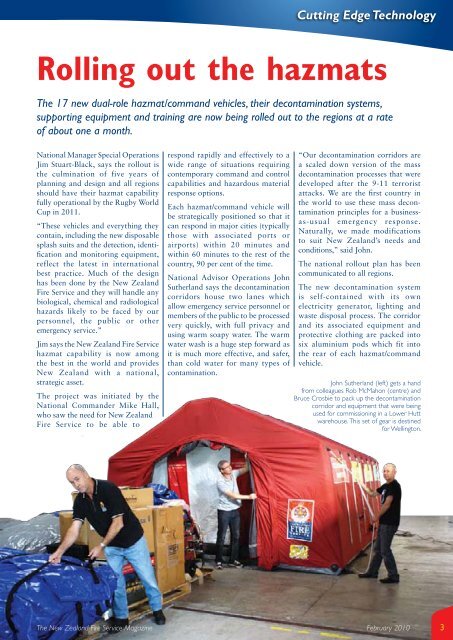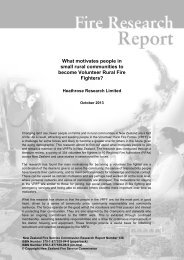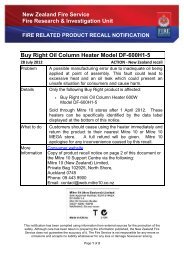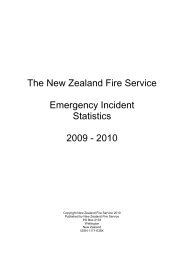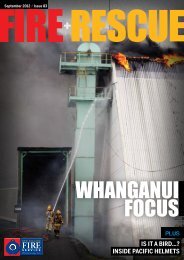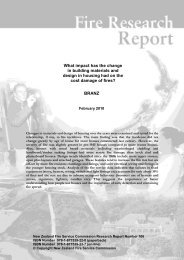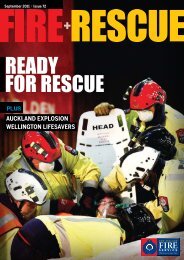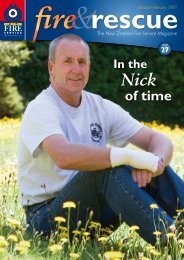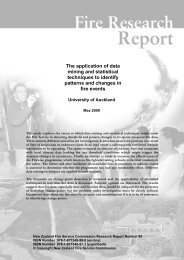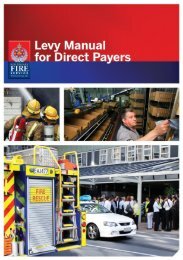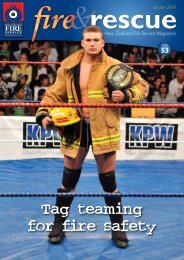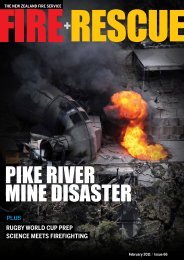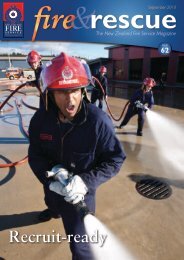Issue 56 - New Zealand Fire Service
Issue 56 - New Zealand Fire Service
Issue 56 - New Zealand Fire Service
Create successful ePaper yourself
Turn your PDF publications into a flip-book with our unique Google optimized e-Paper software.
Cutting Edge Technology<br />
Rolling out the hazmats<br />
The 17 new dual-role hazmat/command vehicles, their decontamination systems,<br />
supporting equipment and training are now being rolled out to the regions at a rate<br />
of about one a month.<br />
National Manager Special Operations<br />
Jim Stuart-Black, says the rollout is<br />
the culmination of five years of<br />
planning and design and all regions<br />
should have their hazmat capability<br />
fully operational by the Rugby World<br />
Cup in 2011.<br />
“These vehicles and everything they<br />
contain, including the new disposable<br />
splash suits and the detection, identification<br />
and monitoring equipment,<br />
reflect the latest in international<br />
best practice. Much of the design<br />
has been done by the <strong>New</strong> <strong>Zealand</strong><br />
<strong>Fire</strong> <strong>Service</strong> and they will handle any<br />
biological, chemical and radiological<br />
hazards likely to be faced by our<br />
personnel, the public or other<br />
emergency service.”<br />
Jim says the <strong>New</strong> <strong>Zealand</strong> <strong>Fire</strong> <strong>Service</strong><br />
hazmat capability is now among<br />
the best in the world and provides<br />
<strong>New</strong> <strong>Zealand</strong> with a national,<br />
strategic asset.<br />
The project was initiated by the<br />
National Commander Mike Hall,<br />
who saw the need for <strong>New</strong> <strong>Zealand</strong><br />
<strong>Fire</strong> <strong>Service</strong> to be able to<br />
respond rapidly and effectively to a<br />
wide range of situations requiring<br />
contemporary command and control<br />
capabilities and hazardous material<br />
response options.<br />
Each hazmat/command vehicle will<br />
be strategically positioned so that it<br />
can respond in major cities (typically<br />
those with associated ports or<br />
airports) within 20 minutes and<br />
within 60 minutes to the rest of the<br />
country, 90 per cent of the time.<br />
National Advisor Operations John<br />
Sutherland says the decontamination<br />
corridors house two lanes which<br />
allow emergency service personnel or<br />
members of the public to be processed<br />
very quickly, with full privacy and<br />
using warm soapy water. The warm<br />
water wash is a huge step forward as<br />
it is much more effective, and safer,<br />
than cold water for many types of<br />
contamination.<br />
“Our decontamination corridors are<br />
a scaled down version of the mass<br />
decontamination processes that were<br />
developed after the 9-11 terrorist<br />
attacks. We are the first country in<br />
the world to use these mass decontamination<br />
principles for a businessas-usual<br />
emergency response.<br />
Naturally, we made modifications<br />
to suit <strong>New</strong> <strong>Zealand</strong>’s needs and<br />
conditions,” said John.<br />
The national rollout plan has been<br />
communicated to all regions.<br />
The new decontamination system<br />
is self-contained with its own<br />
electricity generator, lighting and<br />
waste disposal process. The corridor<br />
and its associated equipment and<br />
protective clothing are packed into<br />
six aluminium pods which fit into<br />
the rear of each hazmat/command<br />
vehicle.<br />
John Sutherland (left) gets a hand<br />
from colleagues Rob McMahon (centre) and<br />
Bruce Crosbie to pack up the decontamination<br />
corridor and equipment that were being<br />
used for commissioning in a Lower Hutt<br />
warehouse. This set of gear is destined<br />
for Wellington.<br />
The <strong>New</strong> <strong>Zealand</strong> <strong>Fire</strong> <strong>Service</strong> Magazine February 2010<br />
3


